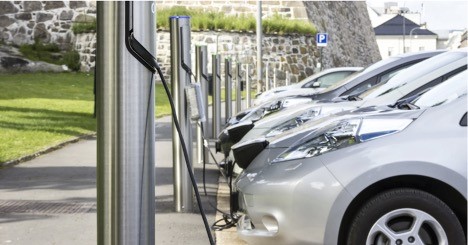Climate, Health and Equity Brief
A promising future for EVs
April 17, 2023

The Climate, Health & Equity Brief is GMMB’s take on the last two weeks’ news on the current impacts of climate change. If you haven’t subscribed yet, you can do so by clicking here.
Hot Topic: Electrifying. This week, the EPA announced the proposal of its strictest emissions standards in American history, which the agency believes will help put a major dent in U.S. transportation-related emissions.
The proposed rules, while still subject to public comments and potential changes, are promising. Transportation accounts for 30% of all greenhouse gas emissions in the United States, and the EPA estimates that these new standards could lead to two-thirds of new passenger vehicles on the market being battery-powered EVs by 2032.
EVs currently make up six percent of new car sales, but demand for EVs has steadily increased in recent years, outpacing supply. The percentage of Americans who reported an interest in buying an EV rose from 4 percent in 2020 to 14 percent in 2022, with experts estimating there are now 45 potential EV buyers for every vehicle produced and 29 electric vehicles for every public charging station available.
Research has shown the primary reasons for reluctance to purchase EVs are price and the lack of charging infrastructure. While the new rules don’t require manufacturers to prioritize EVs, the EPA believes they will compel automakers to increase EV production as companies seek to meet the stricter standards—a move that would drive consumer prices down, increase demand for charging infrastructure, and fuel more private investment in charging stations. All of this adds up to a significant step in the right direction toward more effective reductions in American reliance on fossil fuels.
— Matt and Traci
Human Health
A new study finds that while heat-related deaths are predicted to multiply 60-fold by 2100 in the Middle East and North Africa—a region already grappling with severe drought and warming twice the global average—80% of those deaths can be prevented if arming is limited to 2℃. (Bloomberg)
A new analysis published in the British Medical Journal found that just a small increase in the pollution people breathe—specifically, the fine particles that are released by wildfires, traffic, power plants, and other sources—raises their risk of developing dementia, pointing to need for stronger air quality regulations. (Grist)
Planetary Health
A study in the journal Nature found that the ocean currents—which act as the ocean’s lungs—could face a “catastrophic slowdown” of more than 40 percent in the next 30 years, with devastating impacts on carbon sequestration, marine ecosystems, and the stability of Antarctic ice. (Grist)
According to a new study published in Nature Communications, sea levels across the Southeastern United States are rising three times faster than the global average, suggesting that communities along the U.S. Gulf and Southeastern coastlines could be at even greater risk from rising tides than scientists had predicted. (POLITICO)
A new study published in Nature Geoscience found that chlorofluorocarbon (CFC) emissions, which harm the Earth’s ozone and fuel climate change, are back on the rise after being fully phased out by developed countries in 2000 and by developing countries in 2010. (Inside Climate News)
In an unprecedented move, the Biden Administration is proposing to save what’s left of the Colorado River by reducing the water delivered to California, Arizona and Nevada—three states heavily reliant on the river for their water supply—by as much as one-quarter. (The New York Times)
While California is leading the U.S. in EV adoption, vehicle prices, lack of charging options for renters and inadequate access to public charging stations in low-income and rural communities are hampering expansion beyond the most affluent areas of the state. (Grist)
Equity
The United Nations has requested an advisory opinion from the International Court of Justice on national obligations under international law to protect the environment—a move hailed as a milestone for climate justice. (CleanTechnica)
Politics & Economy
The EPA proposed the strongest-ever federal vehicle emissions standards, which could lead to two-thirds of new passenger vehicles being battery-electric models within just nine years compared to just 5.8% today. (Consumer Reports)
Financial data show that venture capital investment in climate tech development has produced the lowest quarterly fundraising haul for the sector since June 2020, a downturn experts say could have tangible impacts on efforts to combat climate change if it continues. (POLITICO)
Countries spent $1 trillion in 2022 subsidizing fossil fuels for consumers—double what they spent the year before—in an effort to ease consumer prices in the wake of the war on Ukraine, which the IEA says is limiting investments in the clean energy transition and poses a major challenge to climate change mitigation efforts. (The New York Times)
Life as We Know It
A climate denial group, the CO2 Coalition, was banned from a recent science teachers’ convention for distributing a comic book describing the benefits of carbon but no downsides, raising concerns about the spread of climate misinformation to students as more states incorporate climate change into education curricula. (The Washington Post)
Action
A new report predicts that the U.S. will reduce its coal-fired power generation capacity by 50% within the next three years—just 15 years after coal reached its peak in 2011 and sooner than any previous predictions. (Grist)
The Biden Administration will invest up to $450 million to fund up to five clean energy projects—including at least two solar farms—at current or former coal mines. (AP)
In a new study, scientists used 20 years of NASA satellite data to assess the risks of higher temperatures on Belize’s barrier reef system, which they say can also be used to assess risks to other reefs globally from development, overfishing, pollution, and climate change. (NASA)
According to the Alliance for Automotive Innovation, EV market share and demand continue to increase among Americans, but rising prices, geographical disparities, and a national ratio of 29 EVs per public charger are slowing the transition. (POLITICO)
Provisions from the Inflation Reduction Act are spurring new investments and developments in renewable energy projects that convert crops and agricultural waste into low-carbon energy. (The New York Times)
Kicker
Want to better understand the trends in American sentiment about climate change across age, race/ethnicity and gender? Check out Yale’s latest deep-dive and informative graphics on Global Warming’s Six Americas. (Yale Program on Climate Change Communication)
This is the biggest transformation that the auto industry has ever seen.”
– David Haugen, EPA
The GMMB Climate, Health & Equity Brief would not be possible without the contributions of the larger GMMB team— Aaron Benavides, Thomas Baer, Stefana Hendronetto, Sharde Olabanji and Quincy Tichenor. Feedback on the Brief is welcome and encouraged and should be sent to CHandEBrief@gmmb.com.

)




